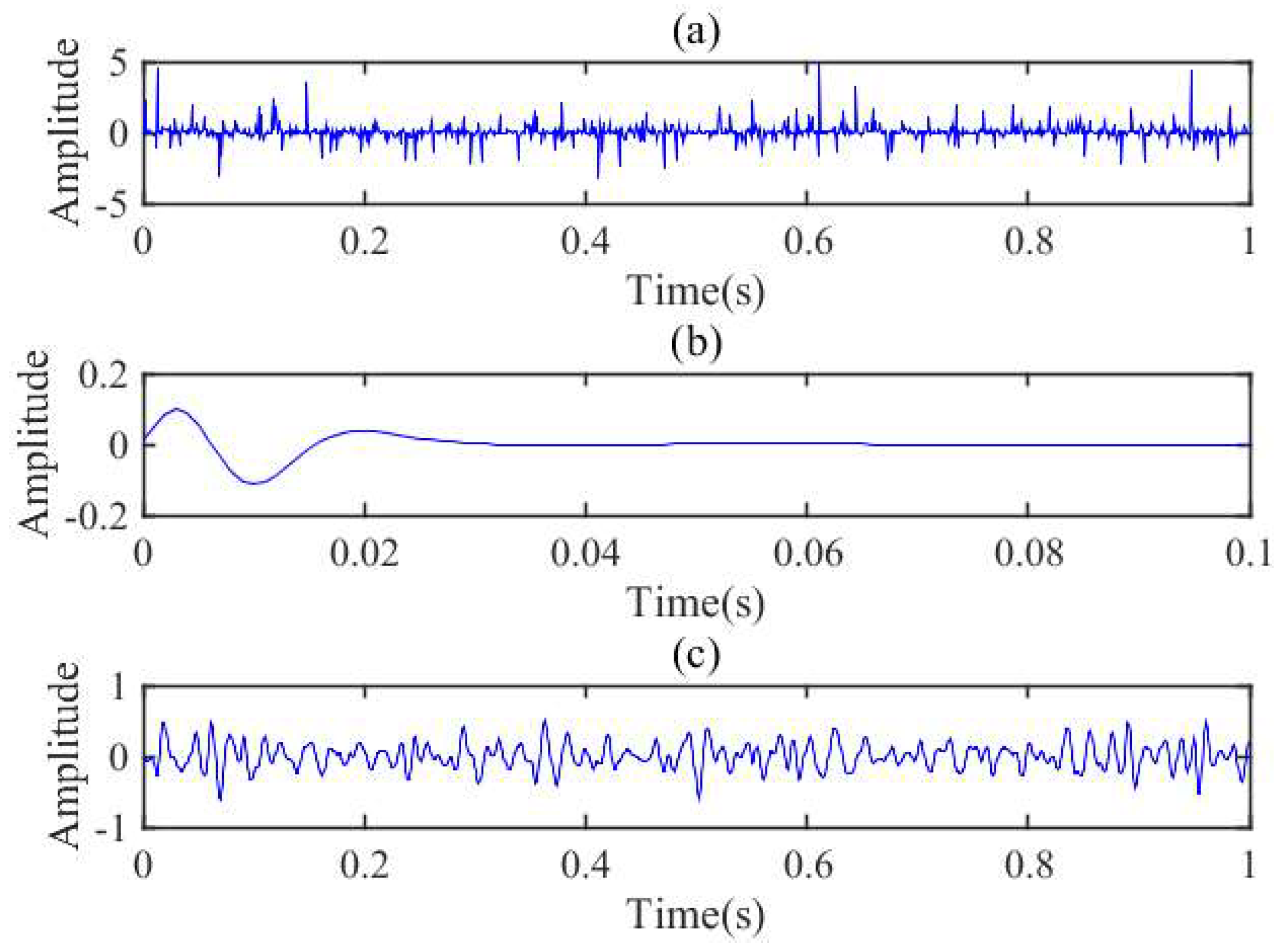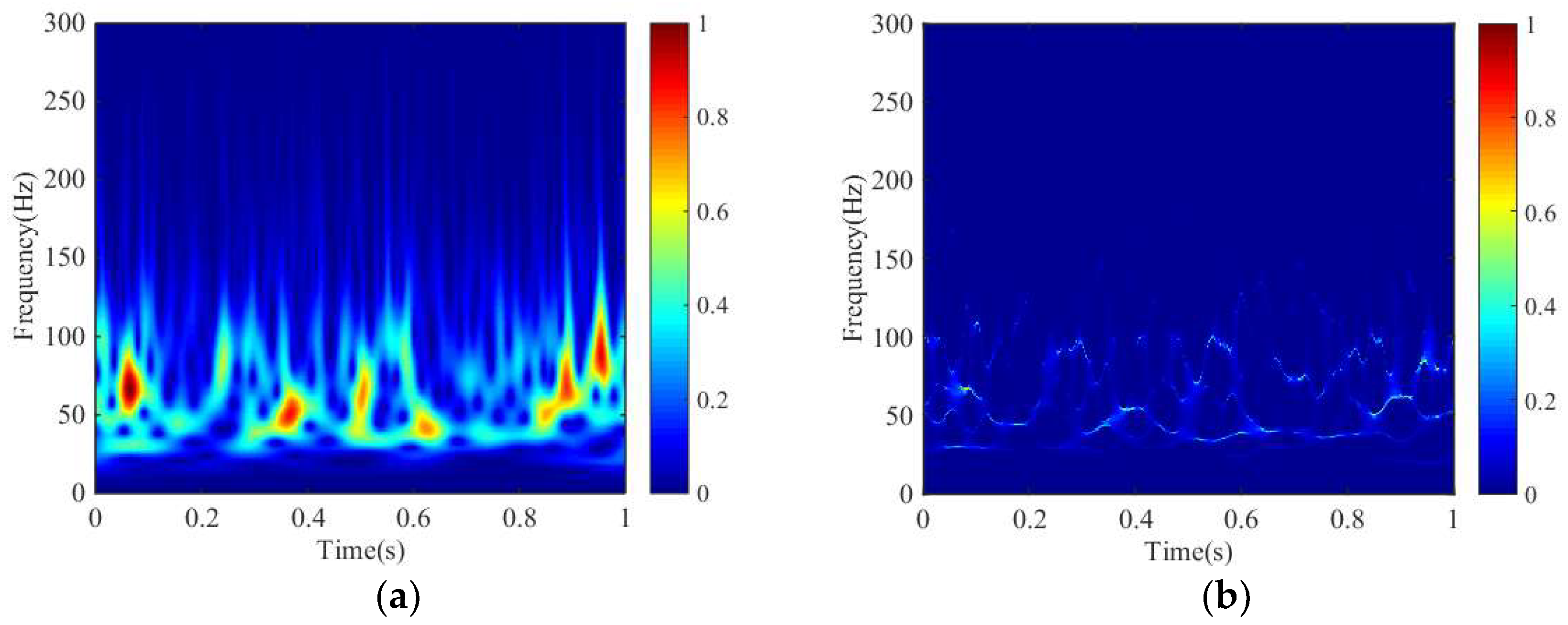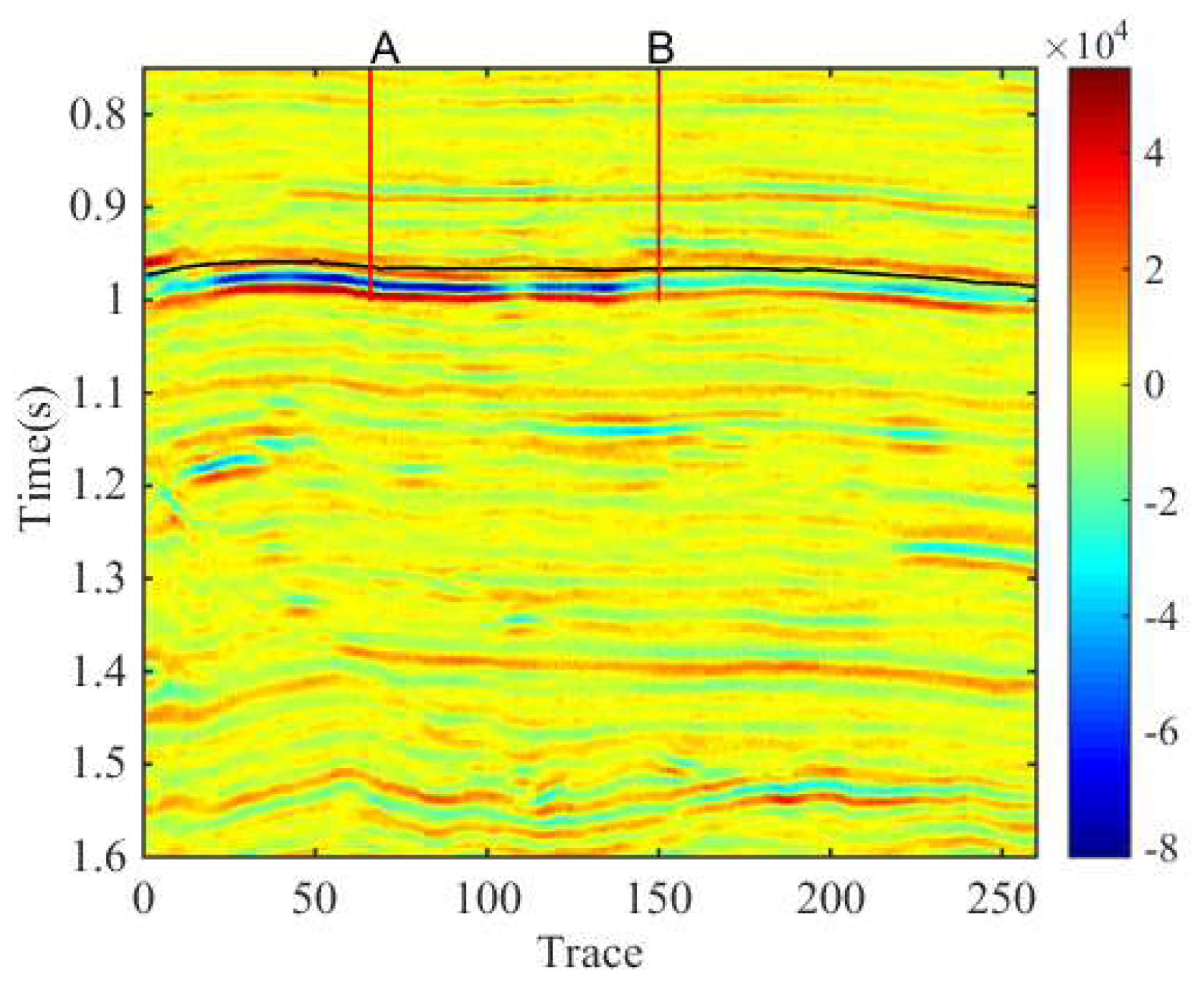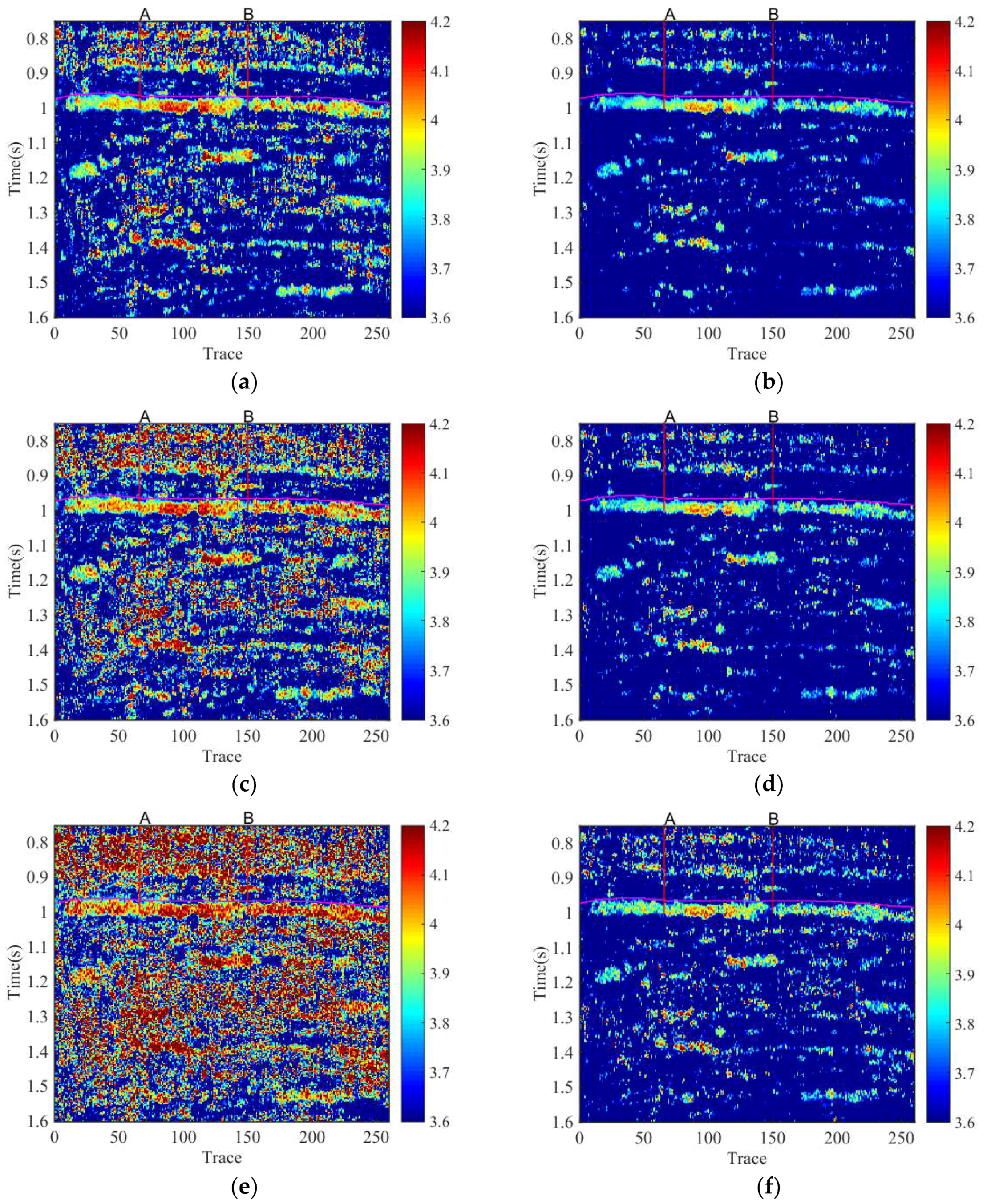A High-Precision Time-Frequency Entropy Based on Synchrosqueezing Generalized S-Transform Applied in Reservoir Detection
Abstract
1. Introduction
2. Materials and Methods
2.1. SSGST
2.2. Time-Frequency Entropy Based on SSGST
3. Synthetic Example
3.1. The Time-Frequency Spectra of a Synthetic Signal Using GST and SSGST
3.2. The Time-Frequency Entropy of Synthetic Signals
4. Field Data
4.1. The Time-Frequency Entropy Comparison
4.2. Hydrocarbon Reservoir Detection Performance Analysis with Different Signal-Noise Ratio (SNR)
5. Conclusions
Supplementary Materials
Author Contributions
Funding
Conflicts of Interest
References
- Xue, Y.J.; Cao, J.X.; Tian, R.F. EMD and Teager-Kaiser energy applied to hydrocarbon detection in a carbonate reservoir. Geophys. J. Int. 2014, 199, 277–291. [Google Scholar] [CrossRef]
- Matos, M.C.D.; Marfurt, K.J. Wavelet transform Teager-Kaiser energy applied to a carbonate field in Brazil. Lead. Edge 2009, 28, 708–713. [Google Scholar] [CrossRef]
- Castagna, J.P.; Sun, S.; Siegfried, R.W. Instantaneous spectral analysis: Detection of low-frequency shadows associated with hydrocarbons. Lead. Edge 2003, 22, 120–127. [Google Scholar] [CrossRef]
- Xiong, X.J.; He, X.L.; Yong, P.; He, Z.H.; Kai, L. High-precision frequency attenuation analysis and its application. Appl. Geophys. 2011, 8, 337–343. [Google Scholar] [CrossRef]
- Cadoret, T.; Mavko, G.; Zinszner, B. Fluid distribution effect on sonic attenuation in partially saturated limestones. Geophysics 1998, 63, 154–160. [Google Scholar] [CrossRef]
- Klimentos, T. Attenuation of P- and S-waves as a method of distinguishing gas and condensate from oil and water. Geophysics 1995, 60, 447–458. [Google Scholar] [CrossRef]
- Winkler, U.K.; Stuckmann, M. Glycogen, hyaluronate, and some other polysaccharides greatly enhance the formation of exolipase by Serratia marcescens. J. Bacteriol. 1979, 138, 663–670. [Google Scholar] [PubMed]
- Tavakkoli, F.; Teshnehlab, M. A ball bearing fault diagnosis method based on wavelet and EMD energy entropy mean. In Proceedings of the International Conference on Intelligent and Advanced Systems, Kuala Lumpur, Malaysia, 25–28 November 2007; pp. 1210–1212. [Google Scholar]
- Yang, Y.; Yu, D.; Cheng, J. A roller bearing fault diagnosis method based on EMD energy entropy and ANN. J. Sound Vib. 2006, 294, 269–277. [Google Scholar]
- Peng, Z.; Chu, F.; He, Y. Vibration signal analysis and feature extraction based on reassigned wavelet scalogram. J. Sound Vib. 2002, 253, 1087–1100. [Google Scholar] [CrossRef]
- Li, C.J.; Wu, S.M. On-Line Detection of Localized Defects in Bearings by Pattern Recognition Analysis. J. Eng. Ind. 1989, 111, 331–336. [Google Scholar] [CrossRef]
- Yu, D.J.; Yang, Y.; Cheng, J.S. Application of time-frequency entropy method based on Hilbert-Huang transform to gear fault diagnosis. Measurement 2007, 40, 823–830. [Google Scholar] [CrossRef]
- Ren, W.-X.; Sun, Z.-S. Structural damage identification by using wavelet entropy. Eng. Struct. 2008, 30, 2840–2849. [Google Scholar] [CrossRef]
- Huang, N.; Chen, H.; Zhang, S.; Cai, G.; Li, W.; Xu, D.; Fang, L. Mechanical Fault Diagnosis of High Voltage Circuit Breakers Based on Wavelet Time-Frequency Entropy and One-Class Support Vector Machine. Entropy 2015, 18, 7. [Google Scholar] [CrossRef]
- Cai, H.P.; He, Z.H.; Huang, D.J.; Li, R. Reservoir Distribution Detection based on Time-Frequency Entropy. J. Oil Gas Technol. 2010, 32, 66–68. [Google Scholar]
- Allen, J. Short term spectral analysis, synthesis, and modification by discrete Fourier transform. IEEE Trans. Acoust. Speech Signal Process. 2003, 25, 235–238. [Google Scholar] [CrossRef]
- Daubechies, I. Ten Lectures on Wavelets; Society for Industrial and Applied Mathematics: Philadelphia, PA, USA, 1992; p. 1671. [Google Scholar]
- Stockwell, R.G.; Mansinha, L.; Lowe, R.P. Localization of the Complex Spectrum: The S Transform. IEEE Trans. Singal Process. 1996, 44, 998–1001. [Google Scholar] [CrossRef]
- Avargel, Y.; Cohen, I. System Identification in the Short-Time Fourier Transform Domain with Crossband Filtering. IEEE Trans. Audio Speech Lang. Process. 2007, 15, 1305–1319. [Google Scholar] [CrossRef]
- Mallat, S.G. A Wavelet Tour of Signal Processing, Third Edition: The Sparse Way; Academic Press: Cambridge, MA, USA, 2009; Volume 31, pp. 83–85. [Google Scholar]
- Dash, P.E.K.; Panigrahi, B.K.; Panda, G. Power Quality Analysis Using S-Transform. IEEE Power Eng. Rev. 2007, 22, 60. [Google Scholar] [CrossRef]
- Sun, S. Examples of wavelet transform time-frequency analysis in direct hydrocarbon detection. Seg Tech. Program Expand. Abstr. 2002, 21, 2478. [Google Scholar]
- Gilles, J. Empirical Wavelet Transform. IEEE Trans. Signal Process. 2013, 61, 3999–4010. [Google Scholar] [CrossRef]
- Mandic, D.P.; Rehman, N.U.; Wu, Z.; Huang, N.E. Empirical Mode Decomposition-Based Time-Frequency Analysis of Multivariate Signals: The Power of Adaptive Data Analysis. Signal Process. Mag. IEEE 2013, 30, 74–86. [Google Scholar] [CrossRef]
- Mcfadden, P.D.; Cook, J.G.; Forster, L.M. Decomposition of gear vibration signals by the generalized S transform. Mech. Syst. Signal Process. 1999, 13, 691–707. [Google Scholar] [CrossRef]
- Pinnegar, C.R.; Mansinha, L. The S-transform with windows of arbitrary and varying shape. Geophysics 2003, 68, 381–385. [Google Scholar] [CrossRef]
- Gao, J.H.; Chen, W.C.; Youming, L.I.; Tian, F. Generalized S Transform and Seismic Response Analysis of Thin Interbedss Surrounding Regions by Gps. Chin. J. Geophys. 2003, 46, 759–768. [Google Scholar] [CrossRef]
- Sejdić, E.; Djurović, I.; Jiang, J. A Window Width Optimized S-Transform. EURASIP J. Adv. Signal Process. 2007, 2008, 672941. [Google Scholar] [CrossRef]
- Chen, X.H.; He, Z.H.; Huang, D.J.; Wen, X.T. Low frequency shadow detection of gas reservoirs in time-frequency domain. Chin. J. Geophys. 2009, 52, 215–221. [Google Scholar]
- Li, D.; Castagna, J.; Goloshubin, G. Investigation of generalized S-transform analysis windows for time-frequency analysis of seismic reflection data. Geophysics 2016, 81, V235–V247. [Google Scholar] [CrossRef]
- Mousavi, S.M.; Langston, C.A.; Horton, S.P. Automatic microseismic denoising and onset detection using the synchrosqueezed continuous wavelet transform. Geophysics 2016, 81, V341–V355. [Google Scholar] [CrossRef]
- Mousavi, S.M.; Langston, C.A. Automatic noise-removal/signal-removal based on general cross-validation thresholding in synchrosqueezed domain and its application on earthquake data. Geophysics 2017, 82, 1–58. [Google Scholar] [CrossRef]
- Auger, F.; Flandrin, P.; Lin, Y.T.; Mclaughlin, S.; Meignen, S.; Oberlin, T.; Wu, H.T. Time-Frequency Reassignment and Synchrosqueezing: An Overview. IEEE Signal Process. Mag. 2013, 30, 32–41. [Google Scholar] [CrossRef]
- Chen, H.; Lu, L.Q.; Xu, D.; Kang, J.X.; Chen, X.P. The Synchrosqueezing Algorithm Based on Generalized S-transform for High-Precision Time-Frequency Analysis. Appl. Sci. 2017, 7, 769. [Google Scholar] [CrossRef]
- Duchesne, M.J.; Halliday, E.J.; Barrie, J.V. Analyzing seismic imagery in the time-amplitude and time-frequency domains to determine fluid nature and migration pathways: A case study from the Queen Charlotte Basin, offshore British Columbia. J. Appl. Geophys. 2011, 73, 111–120. [Google Scholar] [CrossRef]
- Daubechies, I.; Lu, J.; Wu, H.T. Synchrosqueezed wavelet transforms: An empirical mode decomposition-like tool. Appl. Comput. Harmon. Anal. 2011, 30, 243–261. [Google Scholar] [CrossRef]
- Wu, H.; Flandrin, P.; Daubechies, I. One or two frequencies? The synchrosqueezing answers. Adv. Adapt. Data Anal. 2011, 3, 29–39. [Google Scholar] [CrossRef]
- Li, F.; Zhou, H.; Jiang, N.; Bi, J.; Marfurt, K.J. Q estimation from reflection seismic data for hydrocarbon detection using a modified frequency shift method. J. Geophys. Eng. 2015, 12, 577. [Google Scholar] [CrossRef]







| Time (s) | 0–0.3 | 0.3–0.7 | 0.7–1 | |
|---|---|---|---|---|
| The Q Value | ||||
| The Q value of Signal 1 | 50 | 50 | 50 | |
| The Q value of Signal 2 | 50 | 30 | 20 | |
© 2018 by the authors. Licensee MDPI, Basel, Switzerland. This article is an open access article distributed under the terms and conditions of the Creative Commons Attribution (CC BY) license (http://creativecommons.org/licenses/by/4.0/).
Share and Cite
Chen, H.; Chen, Y.; Sun, S.; Hu, Y.; Feng, J. A High-Precision Time-Frequency Entropy Based on Synchrosqueezing Generalized S-Transform Applied in Reservoir Detection. Entropy 2018, 20, 428. https://doi.org/10.3390/e20060428
Chen H, Chen Y, Sun S, Hu Y, Feng J. A High-Precision Time-Frequency Entropy Based on Synchrosqueezing Generalized S-Transform Applied in Reservoir Detection. Entropy. 2018; 20(6):428. https://doi.org/10.3390/e20060428
Chicago/Turabian StyleChen, Hui, Yuanchun Chen, Shaotong Sun, Ying Hu, and Jun Feng. 2018. "A High-Precision Time-Frequency Entropy Based on Synchrosqueezing Generalized S-Transform Applied in Reservoir Detection" Entropy 20, no. 6: 428. https://doi.org/10.3390/e20060428
APA StyleChen, H., Chen, Y., Sun, S., Hu, Y., & Feng, J. (2018). A High-Precision Time-Frequency Entropy Based on Synchrosqueezing Generalized S-Transform Applied in Reservoir Detection. Entropy, 20(6), 428. https://doi.org/10.3390/e20060428





